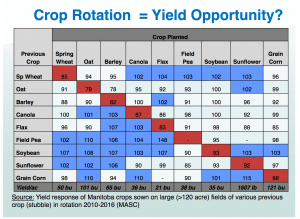Diversified crop rotations are known to help with insect and disease management. A two- or three-year break between canola crops will significantly reduce viable spore counts for clubroot and blackleg in particular, making rotation an import step in managing these diseases. Rotation will also improve crop yields in general. Growers striving for diversity will include cereals, pulses and oilseeds in their rotations. Some will also add perennial hay crops. Recent work indicates that perennial grasses, particularly perennial rye grass, will stimulate clubroot resting spores to germinate but they are unable to complete their lifecycle, subsequently reducing the amount of spores in the soil. This could be a great rotational option for known patches of clubroot.
Agriculture and Agri-Food Canada’s nine-year rotation study
AAFC has a nine-year rotation study comparing continuous Liberty Link canola, continuous Roundup Ready canola, canola in a two-year rotation with wheat and canola in a three-year rotation with peas and barley. Trials were repeated at five locations across the Prairies and “all phases” were repeated each year. For example, for the canola-barley-peas rotation, every phase of the rotation – canola, peas and barley – were grown each year to eliminate the confounding effect of different environmental conditions each year.
When all sites and years are averaged, canola yield improved five bu./ac. with a one year break and another five bu./ac. with a two-year break. While this is an average, results were quite different year to year and site to site. In Melfort, Saskatchewan, for example, there was no yield difference between rotations in 2012, but in 2016, canola yields were 17 bu./ac. higher with a one-year break and 34 bu./ac. higher with a two-year break.
When adding economic analysis to this study, net returns were similar for all rotations averaged across all sites and years.
A concluding document for the study has this statement: “These data refute the notion of continuous canola being the most profitable rotation. Furthermore, these data do not account for increased disease, insect pest and weed threats [from continuous canola] that are likely to threaten sustainable canola cropping over the long term.”
Manitoba rotation data
Manitoba crop insurance data for 2010-16 show that any crop tends to yield better when grown in a rotation. Canola seeded into canola stubble, for example, yields 87% of canola on wheat stubble.

Anastasia Kubinec and Roy Arnott from Manitoba Agriculture included these data as well as economic comparisons for various rotations in a presentation at CropConnect 2018.
Further reading:
Canola Watch article “Rotations and risk management”
Manitoba Pulse & Soybean Growers production resources
SaskPulse production tips
Alberta Pulse production tipis
Grow Barley production tips
Flax Council production tips
Guidelines for estimating crop production costs

